Red Devil by Alvin Drysdale

My Red Devil track bike was built by Alvin Drysdale and dates from about 1938. I bought it from Dewey Keaton in Richmond, Virginia in about 1972. Dewey said he got it from “…some old woman…” in Richmond. She had it in her shed, said it belonged to her son who bought it “…a long time ago.” It was in terrible shape.
It had been mostly dismantled and was missing its saddle, seat post and chain. The paint was severely dinged
 up. Butthere was no rust except on the chrome. Dewey said that he had intended to restore it but lost interest so he gave it to me. I knew nothing about it except that it was a Red Devil track bike as evidenced by the lone decal on the down tube. Being before the internet there was no way for me to research it. So I took a few pictures of it, cleaned it up, stripped the paint and repainted it Candy Apple Red. I had no idea at the time how important those pictures I took in 1972 would turn out to be.
up. Butthere was no rust except on the chrome. Dewey said that he had intended to restore it but lost interest so he gave it to me. I knew nothing about it except that it was a Red Devil track bike as evidenced by the lone decal on the down tube. Being before the internet there was no way for me to research it. So I took a few pictures of it, cleaned it up, stripped the paint and repainted it Candy Apple Red. I had no idea at the time how important those pictures I took in 1972 would turn out to be.
The Lobdell maple rims were in fine shape and the wheels easily built back up. I kept the Red Devil for two years then sold it to my friend Bruce Burgess for $250. In about 1984 Bruce moved to Vermont. I had thought about and wanted that bike back since it left town and in about 2012 I tried, with no luck, to find Bruce in Vermont. So I pretty much gave up ever getting the Red Devil back.
years then sold it to my friend Bruce Burgess for $250. In about 1984 Bruce moved to Vermont. I had thought about and wanted that bike back since it left town and in about 2012 I tried, with no luck, to find Bruce in Vermont. So I pretty much gave up ever getting the Red Devil back.
“Hey, Bruce. I want that Red Devil back.”
In 2014 I had a brainstorm and asked my Two Wheel Travel lbs friend Dee Wittington if he had any contact with Bruce. He gave me Bruce’s phone number and email address. So I called Bruce and said, “Hey Bruce. I want that Red Devil back”. He had taken it to Vermont and it had been hanging in his Vermont garage since 1984. Never ridden. It still had 1974 Richmond Virginia air in its tires! So Bruce sold it back to me for what he had paid for it adjusted to 2014 dollars. I paid him $518. The Red Devil was in excellent shape though my Candy Apple Red paint was severely cracked. Amazingly, after all those cold winters in Vermont, the rims were still solid. This Red Devil had literally been a barn find for me twice! 
So here the plot thickens. With the advent of the internet, I was able to find some documentation on the Red Devil. Alvin Drysdale is probably the most recognizable builder of track (fixed gear) bikes from the 1930’s though his building career lasted until the 1960’s, a couple of decades after the fade of American track racing. During the 1950’s and 1960’s he built mostly road bikes. Drysdale was a prolific builder but little is known about him. He was probably an alcoholic. We know of several addresses he worked at in New York City. We think that he probably worked alone though it’s possible he had helpers. There is little on the internet about him but what is there is interesting. Drysdale built several models of his track bikes. The Ace, the Velox, the Red Devil and the Drysdale, the Alvin, the White Flyer and the Drysdale Special. The “Drysdale” labeled bikes were built to spec and, along with the White Flyers, were his top models. Drysdale is commonly thought of as the builder of many of the bikes that were used in the famous Six Day races but I have not been able to document that and have been told by an expert that it was not true. On the other hand, another Six Day historian told me that Drysdale’s bikes were frequently ridden in these top tier events. So who knows? Fixed gear bicycle racing was very popular in the 1930’s. The city of San Jose California had five velodromes at one time and there were dozens of others in cities coast to coast. In addition, fixed gear bicycles were used in road races as multi-geared bicycles had not made their appearance in this country. 
I love history in general and the history of my own bicycles in particular. So I started networking to find out as much as I could about Drysdale and the Red Devil. The Classic Rendezvous is a Google group that attracts a lot of very knowledgeable bike historians, collectors and people with just a ton of bicycle information. I highly recommend it. I went to the CR and asked, “Who knows the most about Alvin Drysdale”? The consensus person was Eddie Albert.
“…a journeyman builder…”
Eddie is a retired Sociology Professor Emeritus from Hofstra University. He raced bikes, has a very nice collection of early track bikes, and has written about the Six Day era when bicycle track racing was at the top of American and European popularity in the 20’s and 30’s. Eddie is knowledgeable about racers, tracks, velodromes and races of the Six Day era in the East but most interestingly to me he, as a sociologist, understands bikes in the social and cultural context of the era in which they were built and ridden. Eddie described Drysdale as a “journeyman” builder who built strong, light, reliable, affordable track bikes for a wide range of prices. He said that Drysdale’s customers were most likely working class guys who rode their fixed gear track bikes to work ( This was during the Depression) then raced the same bike on the weekend on grass outdoor tracks, the road, or one of the many velodromes that were in the country at that time. I called Eddie twice, recorded about two hours of conversation and asked him thirty or forty questions about Drysdale, the Red Devil, and racing of that era. The history is very important to me. Eddie guessed that the Red Devil was from the late 30’s and the stamping on one crank arm indicates “1938”.
I have found newspaper documentation of a fixed gear road race south of Richmond, Va. in the late 30’s and I like to think that my Red Devil was raced there. Eddie was very gracious in helping me keep this build reasonably historically accurate and has sold me a period appropriate seat pin and Brooks B-17 saddle. Without Eddie’s help, this project would have been weak at best.
One of the most interesting things Eddie told me about Drysdale was that his bicycle painting shop was at one time located on the floor below his hearth brazing frame building- a potentially volatile combination of paint fumes and fire. 
“…mystical to me.”
When I blasted my 42-year-old Candy Apple Red paint off the Red Devil what I saw was like the contents of a time capsule. The 75-year-old steel had started to pit in many places. Most interesting was the file marks Drysdale had left behind, typical of a journeyman builder who was not that interested in aesthetics. Drysdale was able to keep his labor costs low by not cosmetically finishing the metal but was able to cover many of his flaws with his beautiful paint. Being able to touch those marks, where Drysdale’s fingers had touched decades ago…places not touched since I stripped the bike in 1972…was mystical to me. The serial number was there, formerly hidden. Dropping a light down the seat tube showed that it was not just rust free, it looked almost new. A re-build consideration I had was how was I going to cover those file marks with my new paint? When I sent the frameset to Keith Anderson I was skeptical about his being able to cover all of the old pitting and blemishes. I don’t know what kind of voodoo Keith performed but his paint covered every blemish. It’s a beautiful paint job.
“…the only pictures existing of a Red Devil down tube decal.” 
Eddie referred me to Gus Salmon for a reproduction Red Devil down tube decal. The RD, when I obtained it had no head tube decal and only one down tube decal. Eddie said that was common for the period, especially for Drysdale. I needed an accurate picture of a Red Devil down tube decal, in order to make the reproduction and my internet search came up empty. No one had photo documentation of what a Red Devil down tube decal looked like. It’s the little bits of lost history that fall into my lap that have fascinated me in researching my Red Devil because what I DID have were the pictures I had taken in Richmond’s Byrd Park in 1972…pictures of my Red Devil before I stripped the bike. To my knowledge, mine are the only pictures existing of an original Red Devil down tube decal. They showed a decal that looked a lot like the decals that Drysdale put on his other bikes. Gus Salmon makes beautiful. reproduction water slide decals. He makes them from scratch using a lot of research, meticulous attention to detail and fine workmanship.
“…a rebuild not a restoration.” Gus Salmon told me that in a conversation he had with Eddie that Eddie expressed some skepticism about my phone claim to him that the bike was originally orange. Bicycles from that era were generally painted in dark, conservative, automobile colors so an orange bicycle from Drysdale from the late 30’s would have been rare. I haven’t been able to find examples of any other orange painted Drysdale bicycles in existence today.
My Red Devil is a rebuild, not a restoration. The paint, Husqvarna Orange or Stihl Orange, take your pick, is appropriate as per the pics I have of the bike from 1972. Keith Anderson painted it. Unfortunately, Keith also did the box lining which is most definitely not a part of his skill set. His lining on the fork was so bad that I had to have it stripped then chromed. Fortunately for me, nickel or partially nickel plated frame sets were often seen during this era although I did not find this out until I had had the fork chromed.
Custom Chrome Plating in Grafton Ohio plated the fork, bars and stem.  They do beautiful work quickly and with the best customer service I have encountered in any of my builds or rebuilds.
They do beautiful work quickly and with the best customer service I have encountered in any of my builds or rebuilds.
“…aero way before aero became aero.”
I stripped the rims, sanded them and re-stained them dark per Eddie Albert. The Lobdell rims are of the “V” design which came on Drysdales top Red Devil model. A Lobdell catalog described them as being stronger for racing but interestingly they were “V” shaped aero way before aero became aero. Ron Glowczynski of American Flyers Bicycle Shop rebuilt the wheels. They were an interesting build because the spoke holes were drilled thru the veneer wood and aimed toward the appropriate hub hole. VERY interesting because Ron Glowczynski did the SECOND 2016 build of these wheels. Another lbs initially built them up in the Spring of 2016 and got 18 spokes on each wheel in the WRONG hub holes and it cost me $200 to get that mess fixed. Sigh.
The Red Devil has been lightly re-assembled. It’s about eighty years old and I don’t trust the rims or any of the steel enough to tighten everything enough to attempt a ride. 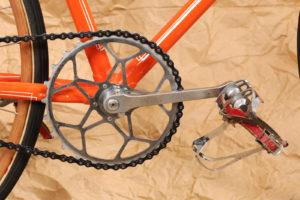
I think my Red Devil, in profile, meets the Golden Ratio of harmony and proportion and as a result is a beautiful bicycle. It’s value to me is that it is woven into the fabric of my life.
SEAT PIN Reynolds Hiduminum alloy 50 R3 26.8
FRAME Probably Reynolds 531 per Eddie Albert
CRANKS – Williams
PEDALS – Phillips
TOE STRAPS Lapieze. Not period appropriate.
HUBS British Hub Co. Mark VI Made in England
BARS No markings
STEM No markings
HEADSET Walton & Brown LTD. Made in England
Rims- Lobdell “V” profile
Serial number 398253
“PS” raised on center of bottom bracket
“Made In England”- Top front and bottom front lugs on the right
“1” on the edge of the bottom bracket
Frame weight 4.0 lbs.
Fork weight 1.1 lbs
Chain ring – Williams 1-inch pitch 24 teeth
Spindle -Walton & Brown Ltd. Made in England 284
Fixed cup- “Made in England”
Bottom bracket lock ring – ” Made in England” 
Chain – Wipperman Not period appropriate
Cog-Campagnolo. Not period appropriate
Adjustable cup – Brampton Made in England
Toe clips – Christophe Special. Not period appropriate.
My Red Devil was assembled by my friend and master mechanic Ron Glowczynski of American Flyers Bicycle Shop in Roanoke Virginia. Ron’s mechanical and, more importantly, his problem-solving skills, were central to getting this old bike together.
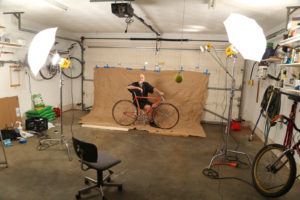
Related Links
Drysdale is a bit of a mystery. Few of his bikes have survived and that is probably because he mostly built track bikes and after all bike racing died in the U.S. there was no need for them. Also, many of his bikes were bought by weekend racers who may have used them for transportation during the Depression and raced them on the weekends. As they became more affluent, they could afford automobiles. Unwanted track bikes were thrown away since they could not be converted for road or city use and were pretty inexpensive to begin with.
The sad story of Alvin Drysdale’s life.
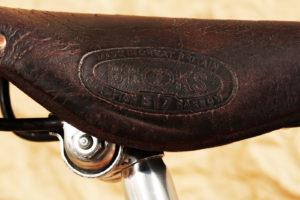
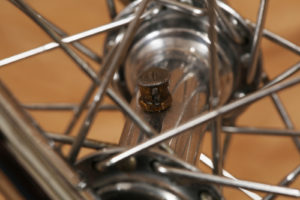
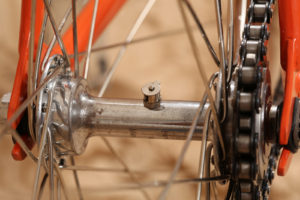
Great work Dick, Glad you made me a part of this project. Very happy to help.
Gus
Thanks Gus!
Lordy lordy lordy am I happy to have found this thread. I’ve been searching for just the right vintage track bike to bring home and love and just found it. The moment I saw the Drysdale ‘Velox’ in it’s original paint, decals and parts having never been molested I was captivated. The bike will be shipped to me soon and I am on pins and needles to get it in my hands and give it all the attention it needs. My plan is to absolutely not restore it. I will retain every bit of it’s hard earned patinae and will ride her.